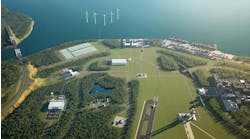With ABB, Emerson and Schneider, all reporting quarterly figures in February, some impression of how the recession has impacted the automation industry is beginning to emerge. What it tends to suggest is that, while the parent companies have weathered the storm and are showing signs of returning to growth, their process automation subsidiaries in particular are still feeling the effects.
That is only to be expected. With the typically long life cycles of automation projects, process automation is more of a lagging than a leading indicator, even if some analysts have suggested that the industry might be "last in, first out." Indeed by accelerating execution on their existing order backlog some vendors may have been improving the current picture only at the expense of what might happen later in the cycle. Certainly most vendors' order books have yet to suggest that good times are just around the corner.
Take ABB, where revenues for the fourth quarter were down 12% in local currency terms and 4% in dollar terms compared with the fourth quarter of 2008 at $8.8 billion, but earnings before interest and tax (EBIT) were up 74% at $800 million, and net income was up 154% at $540 million. Orders, though down 4% in local currency terms, were up 5% in dollar terms at $7.5 billion.
Full-year revenues were down just 4% in local currency terms and 9% in dollar terms compared with 2008 at $31.8 billion, while EBIT was also down 9% at $4.1 billion and net income down 7% at $2.9 billion. Return on capital at 27% was, according to CEO Joe Hogan, "well within our profitability target despite the worst recession in memory." But perhaps the most positive sign was that the year-on-year rate of order decline slowed in the fourth quarter while base orders were slightly higher than in the previous quarter.
Orders down
Less promising news in the Process Automation division, however, where fourth quarter revenues were down 17% in local terms and 9% in dollar terms at $1.9 billion on what was admittedly a record fourth quarter in 2008, while EBIT was down 17% at $200 million. Quarterly orders were down 20% in local terms and 11% in dollar terms at $1.3 billion, and the order backlog also fell 11% compared with the fourth quarter of 2008. In the full year revenues fell by 6% in dollar terms to $7.4 billion while EBIT fell 26% to $690 million.
A not dissimilar pattern emerged at Emerson, which reported net sales for the first quarter to December 31, 2009, down 7% on the same period last year at $5 billion. Removing the effects of currency fluctuations and acquisitions reveals an underlying sales decline of 13%, made up of a 4% decline in emerging markets and an 18% fall in mature markets.
Process Management saw sales decline 9% against what had been the highest first quarter sales ever in the previous year, with underlying sales down 17%. Most significant for competitors who have long had their performance benchmarked against Emerson was the decline in segment margin to 15.6% compared with 19.6% in first quarter of 2009.
Meanwhile Schneider reported total sales in the fourth quarter down 10% at €4.1 billion compared with the same period in 2008, with the greatest decline of 13.6% in Europe compared with just 3% in Asia Pacific. Full year sales were down 15.7% at € 15.8 billion and full year EBITA, a modified form of EBIT, was down more than 34% at €1.8 billion.
Reorganizing Schneider
Of Schneider's three business sectors, Automation and Control saw the greatest full-year decline in sales at 21.3% compared with electrical distribution, down 13.4%, and Critical Power & Cooling down 13.6%. However, in the fourth quarter Automation & Control was down only 9.1% compared with 13% for Electrical Distribution, but Critical Power & Cooling actually managed growth of 1.1%.
Schneider is currently reorganizing itself into the five new business areas of Power, IT, Industry, Buildings and CST. Based on the 2009 figures, Power would have been far and away the largest with full year sales of €9.1 billion and an EBITA margin of 17.1%, followed by Industry with 2009 earnings of €2.7 billion and EBITA margin of 9.6%.
...but analysts see light at the end of the tunnel
Longbow Research, the Independence, Ohio-based research group which tracks the performance of U.S. automation vendors, reported increased optimism across the industry in its February survey. The majority of its contacts report improved demand and pricing, together with an increased level of quoting activity which they anticipate will translate into hard orders in the second half. "Survey results," says Longbow, "lead us to believe that growth could be higher than current expectations, but we would like to see another marker of improvement before raising estimates further."
Specific market sectors showing signs of pick up relative to other industries include food & beverage, power, utilities, water & wastewater, oil & gas, speciality chemicals and general OEMs, while those still clearly in the doldrums include electrical contractors, commercial construction and refining.
Destocking complete
In Longbow's view the destocking phase of the cycle is largely complete and is giving way to concerns that many distributors are holding insufficient inventory to meet any increase in demand, particularly as suppliers' inventories have also been run down. Any return to restocking in the channel will not reach the levels typical of the period prior to the downturn. Overall, however, Longbow detects a shift towards cautious optimism among its industry contacts, many of whom are expecting a slow first half to be followed by improving demand in the second half, although a minority expect a rather longer timescale.
In the meantime, the Minneapolis-based Global Foresight Group (GFG) has published separate studies into growth the prospects for the Process Instrumentation & Automation (PI&A) industry in North America and Europe. In the U.S., where it estimates the market to have contracted from $7.3 billion to $6.3 billion, it expects stimulus spending to create opportunities in the electric utilities and in water & wastewater. Many such projects will be directed towards increasing throughput from existing facilities and should, therefore, include significant spend on, for example, SCADA, valves and liquid analytical equipment.
Other bright spots identified include the semiconductor equipment industry, with demand up significantly on a very low 2009, onshore oil & gas, with the focus on rapid developments in tight gas and shale gas, and the offshore sector, which has been largely immune to the downturn. Here GFG sees the growth in deepwater developments stimulating interest in technologies such as sub-sea, multi-phase flow measurement and in HART and Fieldbus applications.
With bulk chemical production increasingly moving to the Middle East and Asia, the focus of the North American chemical sector is shifting to higher margin, lower volume performance chemicals and speciality materials including epoxies, urethanes and polymers. For the PI&A industry that should translate into increased demand for flow control equipment, metering pumps, exotic materials of construction, solids flow metering and weighing, and analytical instruments.
A further key trend is increasing demand for services as process manufacturers reduce engineer headcounts in response to recession. Instrument and automation suppliers have the opportunity to respond by expanding the size and scope of their field instrumentation and valve service businesses, providing on-site turnaround project management, equipment repair and rebuilding and on-site and remote monitoring and diagnostics of field instrumentation and valves.
Europe
In Europe, GFG sees PI&A revenue growth being driven by export markets, some of which, such as refining and petrochemicals, will show only slow recovery. Others, however, including food, pharmaceuticals, water & wastewater and power will show higher rates of growth. Among the latter, instrumentation and automation have important roles to play in improving energy efficiency, increasing the output of existing plant and meeting regulatory requirements.
In the oil and gas sector, opportunities exist in developing unconventional gas reserves such as shale gas as in North America and in new pipelines including the proposed 279-km project from Burgas in Bulgaria to the port of Alexandroupolis in northern Greece.
In pharmaceuticals primary PI&A opportunities lie in upgrades to existing instrumentation and control systems to increase throughput of existing plants and to analytical instrumentation to maintain and improve quality standards and meet regulatory requirements for data acquisition and reporting. Sanofi Aventis, for example, is typical of the sector in planning for some 30% of its profit recovery to be based on cost reductions and productivity enhancements in existing facilities.
Similarly the food & beverage sector is undertaking major cost reduction programs and investing in higher margin, premium products. Thus Nestlé plans to invest some 4 to 5% of sales in 2010 on longer-term growth opportunities, mainly in premium brands, while Associated British Foods is targeting much if its European capital spending on reducing energy and water usage and increasing its reliance on renewables.
Conventional vs. renewable
Strong PI&A bookings are also anticipated from the European electric utility sector where major investment is required, although timing depends on resolving the optimum balance between conventional and renewable sources, the availability of funding and, in the U.K. in particular, the planning approval process. Meanwhile, still in the utilities sector, water & wastewater investment driven by regulatory compliance pressures should provide opportunities for vendors of SCADA systems, valves and analytical equipment.
One recent indicator of improving prospects comes from UBIFrance, the press bureau of the French Trade Commission in London, which reported a substantial increase in activity in the first six weeks of 2010 compared with both 2008 and 2009. Many of the enquiries were from French companies and trade associations looking to develop their presence in the U.K. and showing particular interest in such sectors as food & drink and nuclear energy.
Automation and instrumentation vendors should, however, heed the words of Siemens CEO Peter Loescher before getting too excited about their prospects for 2010. "The global economy has probably bottomed," he is quoted by Bloomberg as saying, "But the recovery path will be slow and longer than many anticipate."



